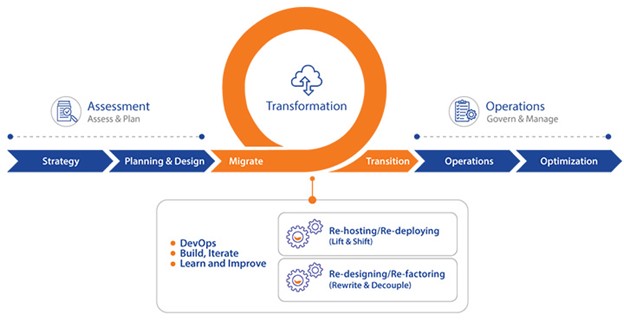-
What We Do
What we do
- Verticals
- Solutions
- Who We Are
Every business is unique, and hence their application portfolios will be different. Cloud migration path for applications will vary from business to business. Everycloud migration initiative should start by analyzing their priorities by asking questions like:
Answers to these questions will help in deciding the most appropriate cloud migration strategy for the business. There are two commonly used paths to cloud migration – the accelerated path and the conventional path. The accelerated path is suited to particular situations, while the conventional path is the most common. This blog will discuss in detail the process, strategies, and approaches leveraged in the conventional migration approach.
Accelerated cloud migration is typically leveraged to quickly transition existing applications to the cloud, mainly to gain the benefits of the cloud faster. This path is primarily suited for mid-sized businesses, as their portfolio of applications will be relatively smaller. Employing automation and tools will enhance success with accelerated migration and will deliver shortened time at lower costs.
The main tasks involved in an accelerated cloud migration path are:
This migration path is typically recommended for medium to large enterprises. A conventional migration path requires a significant investment of time and resources. The complexities involved in large enterprises are many. They could include several diverse stakeholders, applications with varying complexities and inter-dependencies, legacy versus modern applications, lack of documentation, resistance to change, etc. These complexities pose huge risks and business impacts from the migration to the cloud if not thoroughly analysed and create a comprehensive migration plan. You need an experienced cloud migration partner to help you with.
The journey towards a cloud environment has its novel challenges as well as opportunities. Gadgeon’s cloud migration strategy addresses the functional and non-functional requirements to reduce future reworks and ensure higher investments value. We help you navigate through them by preparing a clear roadmap using a three-phased approach that maximizes your benefits and minimises risks.
Every successful cloud migration requires rigorous end-to-end analysis and planning, leading to a clear cloud migration strategy. Establishing a detailed business case with buy-in from all stakeholders is a must. The business case will drive the migration strategy for the enterprise.
Have a clear set of key performance indicators (KPIs) that clearly articulate what is planned to spend and the expected savings from the migration. Typically cloud environment is dynamic, and costs can change rapidly depending on the resources consumed as applications scale. Cost management is critical in ensuring the successful completion of your cloud migration initiatives.
Migration of applications from one cloud platform to another is a lengthy and costly process. Enterprises start cloud services from one vendor and later find it difficult to switch providers if the current platform doesn’t support their requirements. A balanced decision regarding the cloud platforms must be made considering the portfolio of applications, business case, and strategy adopted.
One major challenge seen with cloud migration is the data security and associated compliances gaps. Typically, data security will be the enterprise’s responsibility, while the cloud platform provides robust security measures for the infrastructure. An experienced migration partner can help in designing and implementing appropriate security processes along with tools.
Cloud migrations of large and complex applications are associated with higher risk with crucial business impact. These risks are mitigated by Gadgeon through planning and implementation of an end-to-end iterative migration process that leverages industry best practices, tools, and methodologies. A three-phase migration process with sub-steps, as described in the figure below, is what we recommend.

Figure 1 - Gadgeon's Cloud Migration Process
There are different strategies when it comes to the migration of applications to the cloud. Multiple factors influence the strategy, and it could vary from the portfolio of applications to individual ones. Enterprises should examine all the factors for their application while picking up the most suitable strategy. Brief descriptions of effective migration strategies are as follows:
|
# |
Strategy |
Description |
|---|---|---|
| 1 | Re-hosting |
|
| 2 | Re-platform |
|
| 3 | Revise |
|
| 4 | Rebuild |
|
| 5 | Replace |
|
| 6 | Retire |
|
| 7 | Retain |
|
.jpg)
Figure 2 - Replatform Approach
.jpg)
Figure 3 - Refactor Approach
As we have seen here, there is no single approach that fits all cloud migration requirements. There are many factors involved and should be considered while choosing a method for a particular application or a group of applications. Enterprises need to realise that cloud migration is a time-consuming initiative. They should engage an experienced and flexible partner like Gadgeon for their application migration initiatives to learn the business and operational benefits expected.